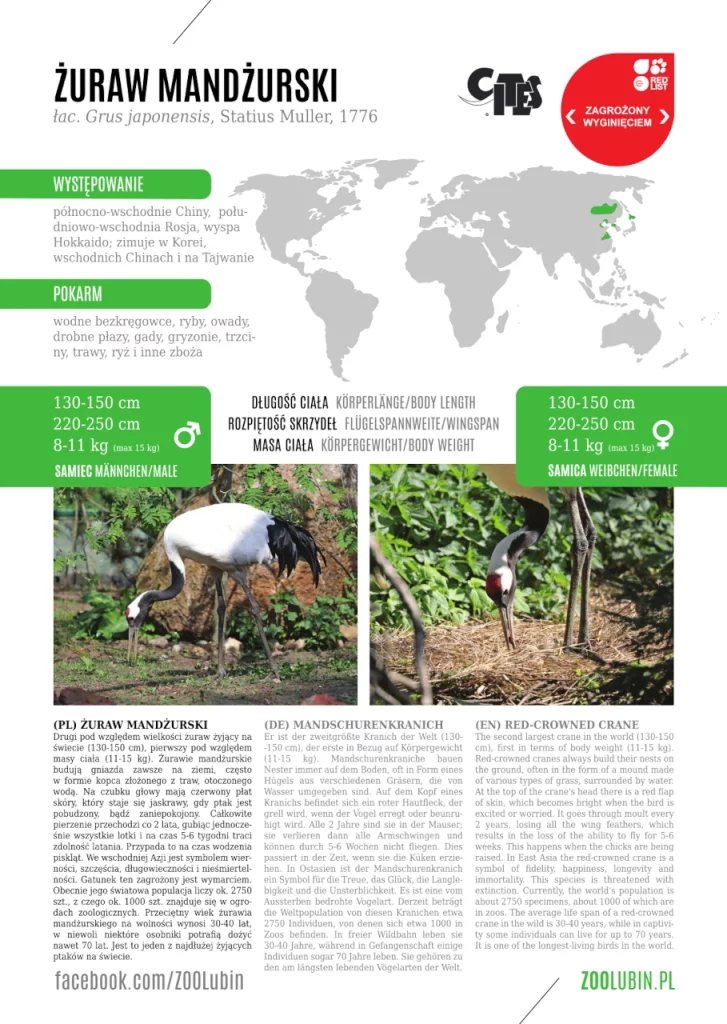
POBIERZ ETYKIETĘ GATUNKOWĄ – PLIK PDF (rozmiar 3157 KB)
Żuraw mandżurski (PL)
łac. Grus japonensis, Statius Muller, 1776
Drugi co do wielkości żuraw świata, pierwszy pod względem masy. Gniazda w formie kopca z traw buduje na ziemi. Na głowie ma czerwony płat skóry, który staje się jaskrawy, gdy ptak jest pobudzony bądź zaniepokojony. Całkowite pierzenie przechodzi co 2 lata, tracąc zdolność latania na 5–6 tyg. Przypada to na czas wodzenia piskląt. We wschodniej Azji jest symbolem wierności, szczęścia, długowieczności i nieśmiertelności. Gatunek zagrożony wymarciem. Obecnie światowa populacja liczy ok. 2750 szt., z czego ok. 1000 szt. znajduje się w ogrodach zoologicznych. Przeciętny wiek żurawia mandżurskiego na wolności wynosi 30–40 lat, w niewoli potrafią dożyć nawet 70 lat. Jest to jeden z najdłużej żyjących ptaków na świecie.
Występowanie: pół.-wsch. Chiny, płd.-wsch. Rosja, Hokkaido; zimuje w Korei, wsch. Chinach i na Tajwanie
samiec / samica
Długość ciała: 130–150 cm
Rozpiętość skrzydeł: 220–250 cm
Masa ciała: 8–11 kg (max. 15 kg)
Mandschurenkranich (DE)
łac. Grus japonensis, Statius Muller, 1776
Es ist der zweitgrößte Kranich der Welt; der erste in Bezug auf Körpergewicht. Der Mandschurenkranich baut Nester auf dem Boden, in Form eines Hügels aus Gräsern. Auf seinem Kopf befindet sich ein roter Hautfleck, der grell wird, wenn der Vogel munter oder beunruhigt wird. Alle 2 Jahre geht er die Mauser durch; er verliert dann alle Armschwingen und kann für 5–6 Wochen nicht fliegen. Dies fällt in der Zeit kurz nach dem Schlüpfen der Küken. In Ostasien ist der Mandschurenkranich ein Symbol für Treue, Glück, Langlebigkeit und Unsterblichkeit. Es ist eine vom Aussterben bedrohte Vogelart. Derzeit beträgt die Weltpopulation dieses Kranichs etwa 2750 Individuen, von denen 1000 sich in Zoos befinden. In freier Wildbahn leben sie 30–40 Jahre, während in Gefangenschaft einige Individuen das Alter von 70 Jahren erreichen. Sie gehören zu den am längsten lebenden Vögeln der Welt.
Vorkommen: Nordostchina, Südostrussland, Insel Hokkaido; im Winter Korea, Ostchina und Taiwan
Männchen / Weibchen
Körperlänge: 130–150 cm
Flügelspannweite: 220–250 cm
Körpermasse: 8–11 kg (max. 15 kg)
Red-crowned crane (EN)
łac. Grus japonensis, Statius Muller, 1776
The second largest crane in the world; first in terms of body weight. Red-crowned cranes build their nests on the ground, in the form of a mound of various types of grass. At the top of the head they have a red skin flap, which becomes bright when the bird is excited or upset. It goes through moult every 2 years, losing all the wing feathers, which results in the loss of the ability to fly for 5–6 weeks. This happens in the time when the chicks are being raised. In East Asia the red-crowned crane is a symbol of fidelity, happiness, longevity and immortality. This species is threatened with extinction. The world population currently counts about 2750 specimens, about 1000 of which are in zoos. The average lifespan of the red-crowned crane in the wild is 30–40 years, while in captivity it can live for up to 70 years. It is one of the longest-living birds in the world.
Distribution: Northeast China, Southeast Russia, Hokkaido Island; winters in Korea, East China and Taiwan
male / female
body length: 130–150 cm
wingspan: 220–250 cm
body mass: 8–11 kg (max. 15 kg)
